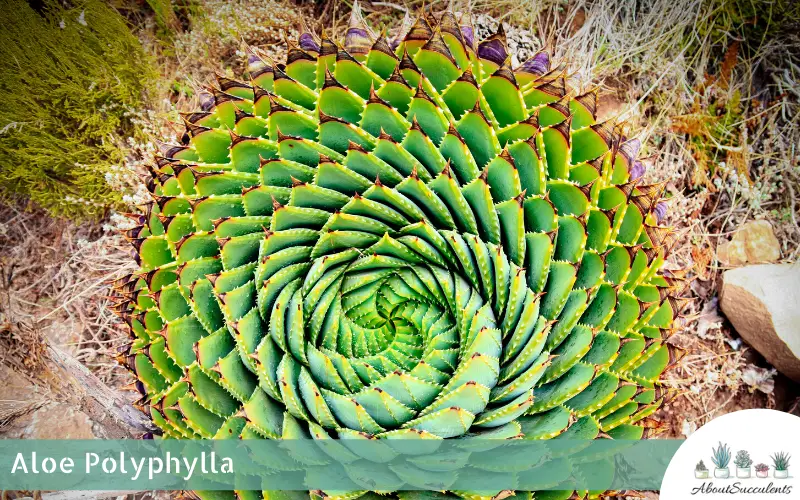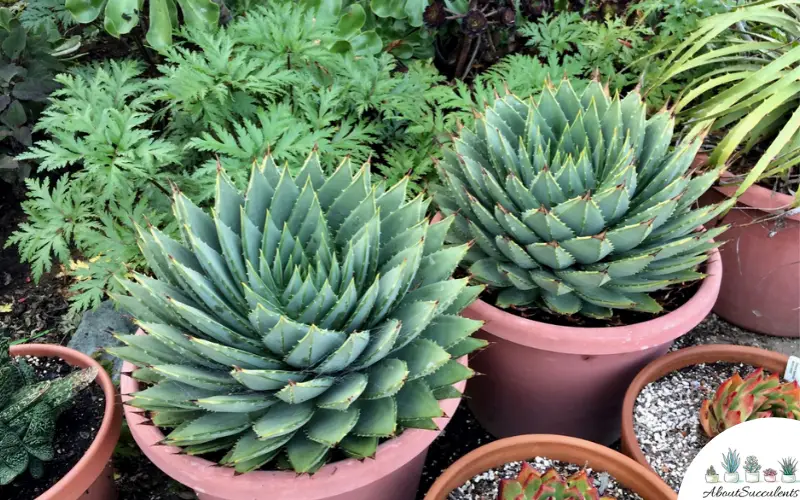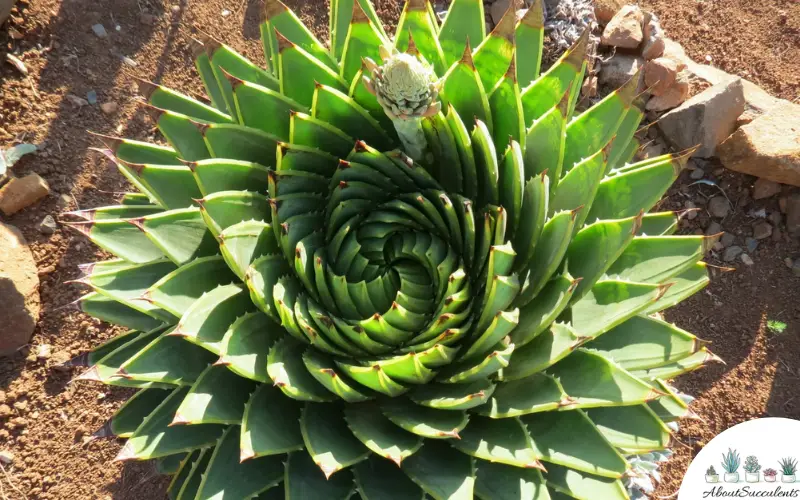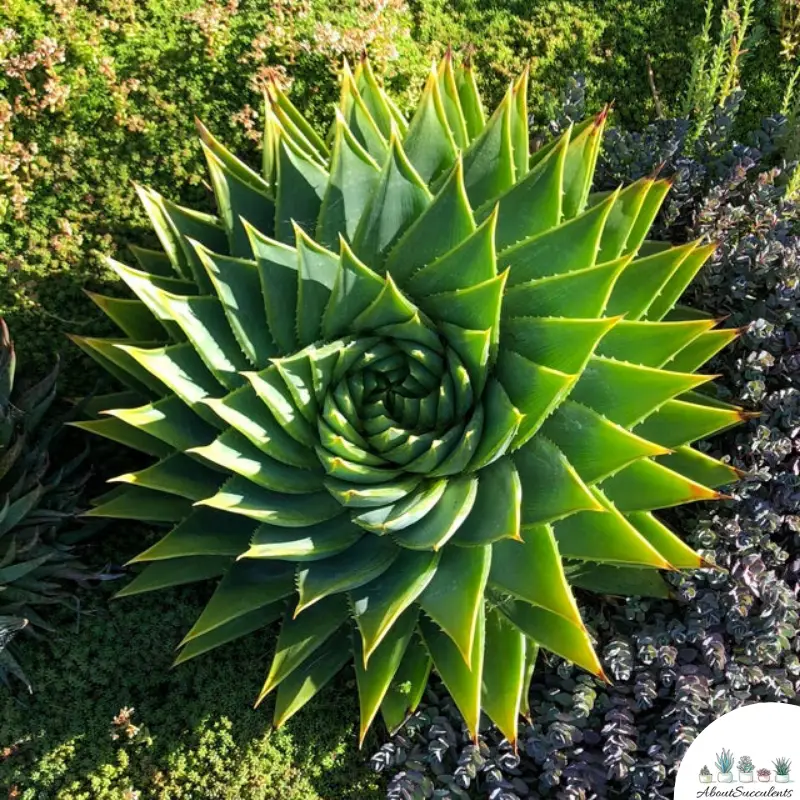
Aloe polyphylla is a mesmerizing succulent. Many growers consider it the most beautiful aloe because of the unique spiral formation of it leaves which has a greyish-green color. This is why the succulent is also called “Spiral Aloe”. Its name, “polyphylla” is derived from 2 Greek words – “poly” which means “many” and “phylla” or “leaves”.
The spiral formation of Aloe polyphylla is its most striking feature and is the main reason why growers are motivated to plant it in their respective gardens. Whether the spiral moves clockwise or counter-clockwise, the leaves are arranged in a way that the spiral looks perfect.
Each turn of the spiral has around 15 to 30 leaves. The leaves of Spiral Aloe are wide and have sharply-pointed tips that are purplish-brown in color. The succulent produces salmon-pink colored flowers in the spring and early summer.
Aloe polyphylla originates from the Aloaceae family and is native to the Maluti Mountains of Lesotho. It can grow up to 12-inches (30cm) in height. Because of the high demand for this succulent plant and its specific requirements for growing, Spiral Aloe has been listed as an endangered species.
General Information:
Also known as: Spiral Aloe
Plant Family: Aloaceae
Origin: Maluti Mountains of Lesotho
Height: 12-inches or 30cm
Exposure: Full to partial sunlight up to 6 hours per day
Water Needs: Light watering schedule during the summer months; very little to no watering in the winter or cold season.
Soil Type: 1 part potting soil to 1 part pumice or lava rock with around 25% horticultural sand added to the mix.
Soil pH: Acidic (5.5 to 6.0 pH)
Tolerance: Drought

How To Grow Aloe Polyphylla
Growing Aloe polyphylla can be challenging. The succulent has specific growing conditions which is one reason why it has been listed as an endangered species.
For one thing, Spiral Aloe is not a cold-hardy plant. If you are located in a region which can get temperatures below 30° F (-1.1° C), it would be advisable to grow the succulent in a pot and placed indoors.
Aloe polyphylla will not survive hot regions where nights can get very warm. The plant should be protected from excessive winds, freezing, and wet conditions.
1. Sunlight
In warm climates, Aloe polyphylla thrives under full to partial sun. If you want to grow Spiral aloe in your garden, look for an area that receives 6 hours of morning sunlight every day.

2. Watering
The leaves of Spiral Aloe are thick because it stores water. This type of succulent needs less water than other varieties.
Give Aloe polyphylla water only when its soil feels dry to the touch. Overwatering the plant will cause its roots to rot.
During the wintertime, reduce the frequency of watering as the soil tends to retain moisture longer.
3. Pot and Soil
For Aloe polyphylla, use a pot that has good drainage but make sure it is not a dark-colored container that has been observed to retain moisture longer than light-colored ones.
The best soil for Aloe polyphylla is a variety that is well-aerated with excellent draining properties, free of lime and has a soil pH factor of 5.5 to 6.0.
A good combination is 1 part potting soil to 1 part pumice or lava rock with around 25% horticultural sand added to the mix.
How To Propagate Aloe Polyphylla

The best method for propagating Aloe polyphylla is through offsets. If you try to propagate the succulent from leaves, there is a great probability of the leaves rotting.
You may also try to propagate the Aloe polyphylla succulent by growing it from seeds but it is very difficult and will take time.
Propagation through the use of offsets is the best approach for this type of succulent. It may take years before Spiral Aloe develops offsets but the wait will be worth it.
Step 1: Wear gloves before removing the offsets.
Step 2: Use a sharpened and sterilized knife or garden shears for removing the offsets.
Step 3: Once you have removed the offset, clean its bottom part.
Step 4: Place the offset in a shaded and dry area to allow it to harden or develop calluses.
Step 5: When the offset has developed calluses, plant it in a pot filled with well-draining soil.
Frequently Asked Questions
Is Aloe Polyphylla Toxic for Cats and Dogs?
Yes, Aloe polyphylla can be toxic for cats and dogs. This variety of succulent plant has been identified as potentially poisonous when ingested by animals on the website of the American Society for the Prevention of Cruelty to Animals (ASPCA).
If you have Aloe polyphylla in your garden, your pet may be in danger of getting ill once it comes in contact with the plant. Look out for signs of depression, vomiting, and gastrointestinal distress.
Why is my Aloe Polyphylla Succulent Dying?
Aloe polyphylla is a high maintenance succulent plant. If proper conditions to support its growth are not achieved, Spiral Aloe can die.
There are 3 possible factors that could lead to the death of your Aloe polyphylla – overwatering, extreme cold, hot temperatures, and infestation.
Overwatering
Like all succulents, overwatering can lead to the plant’s roots rotting. Aloe polyphylla can survive long periods without water because its plump leaves have the ability to store water.
Make sure the tray under the pot of the plant has been cleared of excess water. Use well-draining soil that will allow air to circulate freely around the plant’s roots.
If you see any part of the plant developing a brownish color, cut it off right away with a sterilized knife. That could be a sign of rotting which can spread and infect the rest of the plant.
Exposure to Cold Temperatures
Aloe polyphylla is highly sensitive to cold temperatures especially when it hits below freezing point.
Under freezing conditions, the leaves can develop rot right away. The best solution is to transfer the succulent indoors and place it in an area with temperatures that do not go lower than 30° F (-1.1° C).
Exposure to Hot Temperatures and Dry Air
Aloe polyphylla can also rot when exposed to hot temperatures and dry air. In situations such as these, move the plant indoors and place it in a room where the temperatures do not go above 82 to 86° F (28 to 30° C).
Does Aloe Polyphylla Produce Flowers?
It may take years but Spiral Aloe produces attractive salmon-pink flowers that measure 12-inches or 30cm in the spring or early summer. In rare occurrences, the succulent may bloom yellow-colored flowers.
Last Updated on June 10, 2022 by Sofia Lara